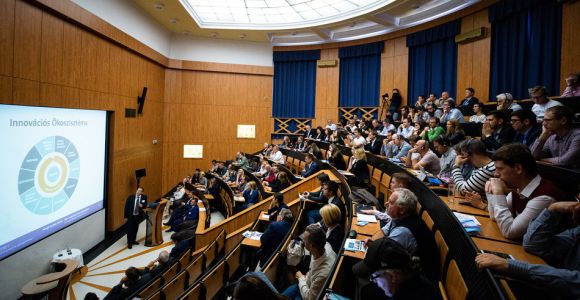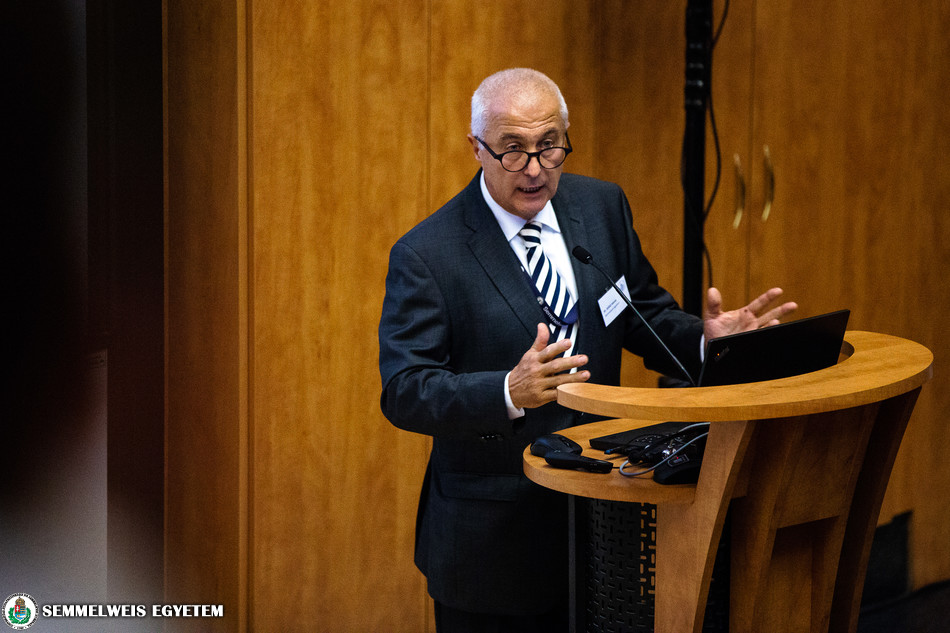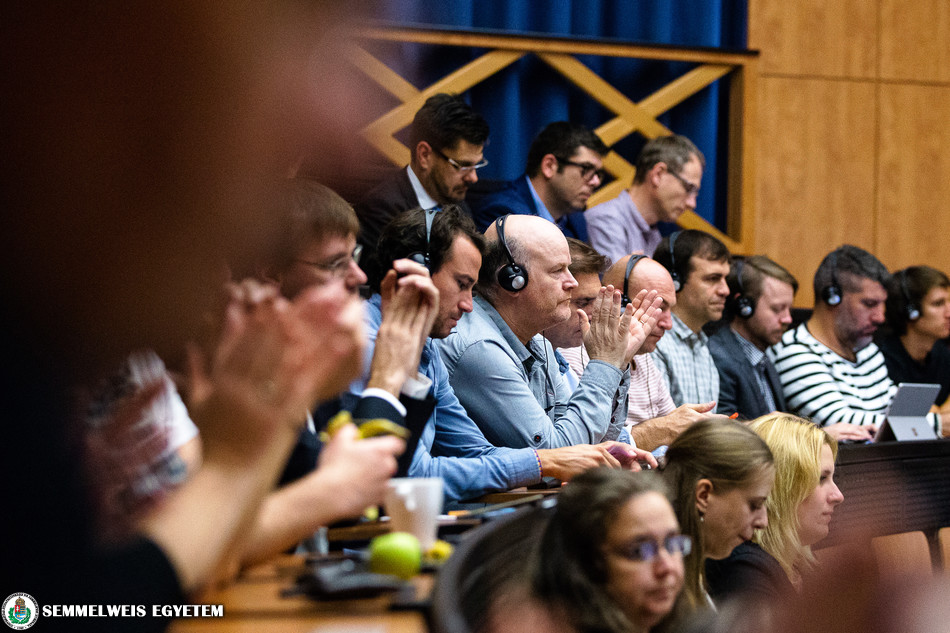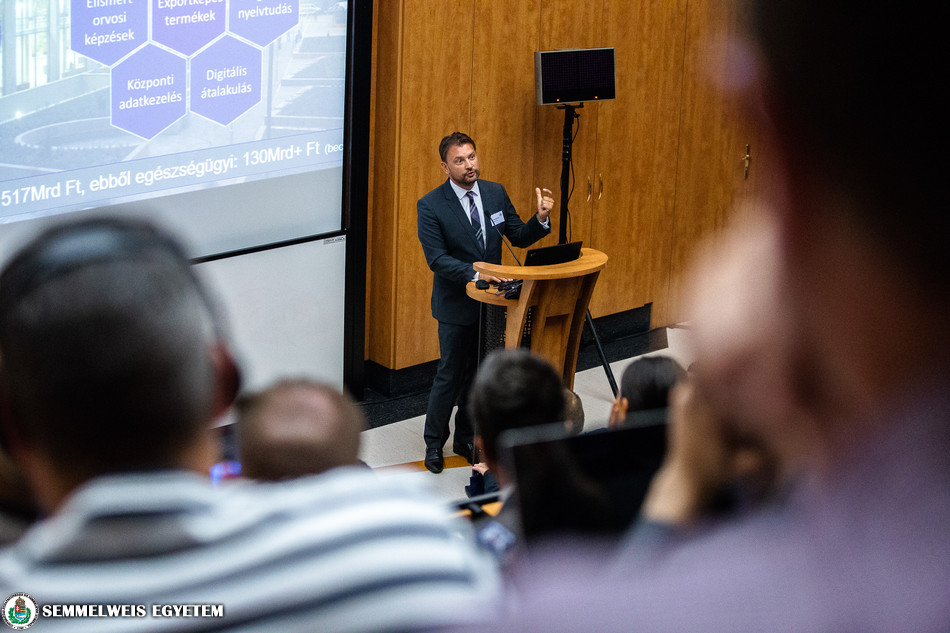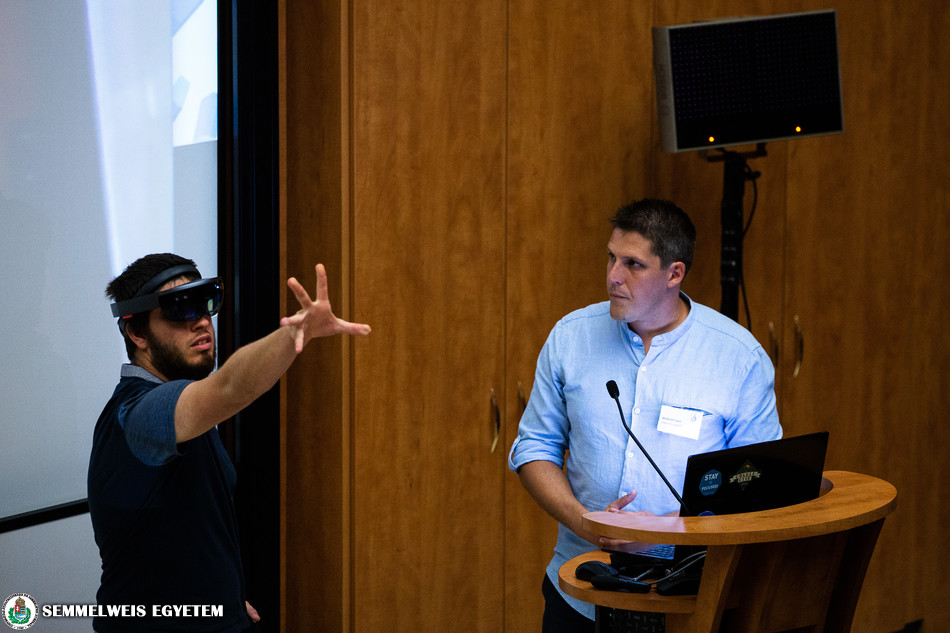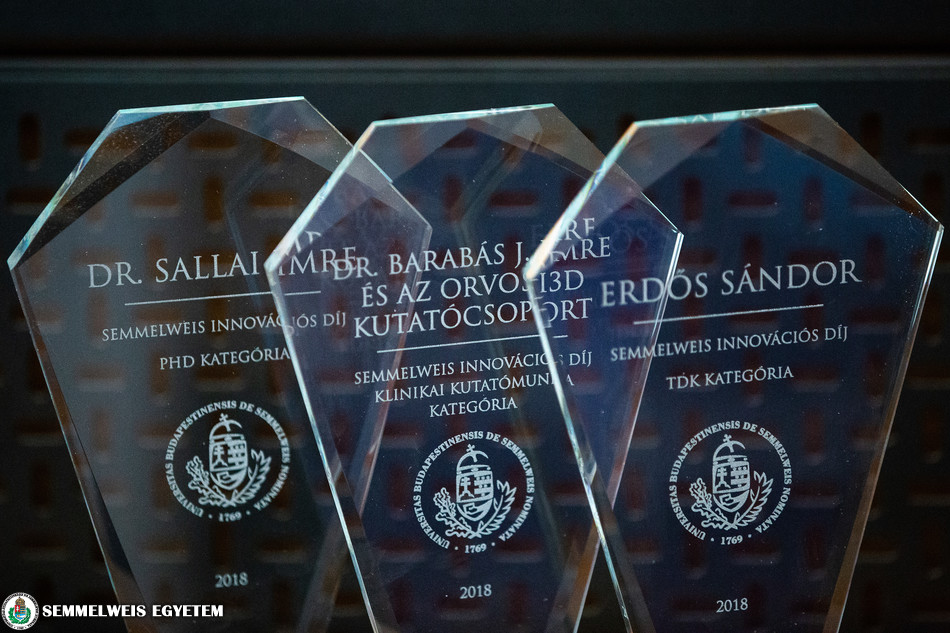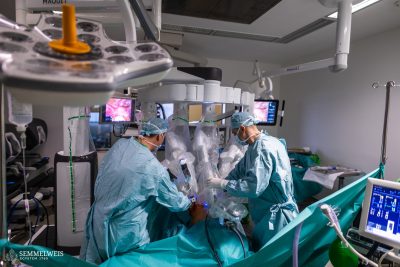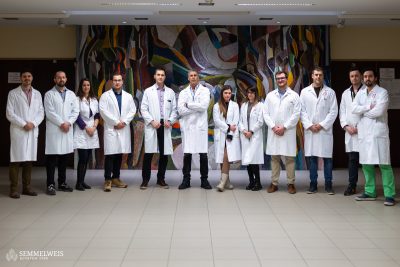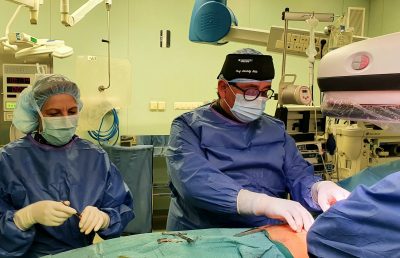Innovation Day was held for the fourth time at the university, opened by Dr. Péter Ferdinandy, Vice-Rector for Scientific Affairs and Innovation, and Dr. Károly Szász, Chancellor. Following the professional lectures, this year’s Innovation Awards were conferred in the three categories: clinical researcher, PhD and Students’ Scientific Association.
“The goal of the leadership of Semmelweis University is to increase the university’s innovation potential, and there is a perfect consensus between the Chancellor and the Rector in this regard, and that is the direction in which things are going”, said Dr. Péter Ferdinandy, Vice-Rector for Scientific Affairs and Innovation, in his opening speech. He reminded everyone that the increase of the innovation potential is part of the rector’s programme, and he also has a personal conviction that it is necessary for further developing the university and Hungary’s economy, and it also provides the basis for progress in international rankings. The vice-rector emphasized that the upswing of innovation can be achieved primarily by changing the way of thinking. Dr. Péter Ferdinandy congratulated the winners of the Innovation Award and all the applicants, as they have already proven to be aware of the importance of innovation and lead by example. He also recalled that several projects of the previous awardees could be put into industrial use with the help of the Directorate of Innovation.
Dr. Károly Szász, Chancellor, called universities the most important institutions of human resource formation, which have been the most important players in the dissemination of economic and social innovation for centuries. The Chancellor explained how the universities’ relevant responsibilities have changed over history. As he said, it is becoming more and more important these days how to transform intellectual knowledge and ability into economic power; this is also a challenge for the university. In a broader sense, this process is linked to social responsibility, since it is important that the scientific world finds contact with the non-academic world. In a narrower sense, the utilization of knowledge means the need to become a business-type university, which is based on the fact that the university must diversify and should not be exposed to the market”, said the Chancellor, pointing out that this approach has strengthened at Semmelweis University in the past years. Dr. Károly Szász emphasized that today’s universities should act as lighthouses and leading examples, instead of living in isolation.
András Balogh, head of the Directorate of Innovation, said that the Directorate is a bridge between science and industry or business life. Among their main activities, he mentioned application project management, application portfolio management, utilization of intellectual creations generated at the university, as well as the management of industrial relations. Regarding their goals, he said: in line with the strategy set by top management, they would like Semmelweis University to be included in the Reuters European Innovation Ranking, as the measures taken in order support the inclusion among the world’s top 100 universities. Additionally, they would increase the average annual number of patent applications from one to ten, and would also increase university revenues from industrial co-operations. Over the last six months, it has been possible to move forward with the latter two, as five patent applications have been realized so far, and the university has achieved the largest industrial revenue of the past five years from utilizing one of its patents.
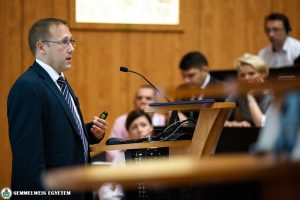 András Balogh announced several new services of the Directorate of Innovation, including publication pre-screening. They undertake the responsibility to check within 10 days that the scientific article is protected from any form of infringement of intellectual property described therein. The researcher in question has a statutory obligation to report to the university any intellectual creation (invention, exploitable research finding) created by him. The Directorate helps to streamline this reporting process. Depending on the outcome of the pre-screening, the researcher can obtain patent priority within 60 days, said András Balogh, adding that their goal is to exempt researchers from the administrative burden. They would also like to dispel the doubts that patenting may delay publishing for several years, which is crucial to the professional advancement of researchers, he explained.
András Balogh announced several new services of the Directorate of Innovation, including publication pre-screening. They undertake the responsibility to check within 10 days that the scientific article is protected from any form of infringement of intellectual property described therein. The researcher in question has a statutory obligation to report to the university any intellectual creation (invention, exploitable research finding) created by him. The Directorate helps to streamline this reporting process. Depending on the outcome of the pre-screening, the researcher can obtain patent priority within 60 days, said András Balogh, adding that their goal is to exempt researchers from the administrative burden. They would also like to dispel the doubts that patenting may delay publishing for several years, which is crucial to the professional advancement of researchers, he explained.
As a new service, the In-Part Industrial Intermediation Platform is available, which helps research teams find industrial partners and financing, as well as place industrial orders. Patsnap’s patent research platform will soon be in operation, which will help to prove novelty with its constantly updated database containing more than 120 million patents. The Director also drew attention to the announcement of applications for the second year of the Science and Innovation Fund.
At the event Dr. Endre Ascsillán, Vice-President of General Electric Hungary, gave a lecture on the domestic innovations of the healthcare sector, Dr. István Szabó, Vice-President of the National Research, Development and Innovation Office, focused on new emphases in policy and proposal possibilities. In the second block, participants had the opportunity to hear from Levente Zsembery about the domestic investment situation of the healthcare sector, and Zsolt Mihályfi, Managing Director of 360world Europe Ltd., who presented on trends in healthcare technology.
Following the lectures, this year’s Innovation Awards were presented by Dr. Péter Ferdinandy.
In Clinical Research, Dr. Imre Barabás J., a resident in Cardiac Surgery and his research group of the Varosmajor Heart and Vascular Centre, won the award for their work in 3D modelling and flow simulations for complex surgical interventions and reconstructions from DICOM files. Their project, which they have been working on for two years, utilizes the abilities of modern computing in imaging. The use of their own, highly specialized software enables dynamic parameters to be modelled to predict postoperative results, diagnose tumour lesions, and determine the exact location of the tumour. Other members of the research team include Dr. László Rosivall, Dr. Ferenc Rényi-Vámos, Dr. István Hartyánszky and Dr. Béla Merkely.
In the PhD category, Dr. Imre Sallai, resident in the Department of Orthopaedics, received recognition for his doctoral thesis work he began in 2016 with senior lecturer Dr. Gábor Skaliczki pertaining to examination of ortho-vesicle, microvesicles in periprosthetic infections. One of the most serious complications of joint implants is the infection, in connection with which the role of microvesicles has been highlighted recently. The research group has set the goal of examining whether the microvesicles released by white blood cells are measurably present in periprosthetic infections and can serve as diagnostic tools. During their work, a completely new and standard vesicle isolation protocol was developed for which a patent application was made.
The award for the most innovative work conducted by a student in the Students’ Scientific Association was awarded to Sándor Erdős for his research conducted in the 2nd Department of Paediatrics. His research, conducted alongside Dr. Horváth Klára, explored the possibilities of using virtual reality (VR) in the field of children’s oncology. In addition to the subjective, psychological characteristics of VR, it also has the ability to examine the physiological effects in children undergoing chemotherapy. According to his hypothesis, VR treatment decreases, among other things, anxiety, pain and fatigue, and the amount of antiemetics and painkillers consumed. In his view, virtual reality technology can have many positive implications on a person’s hospital stay experience.
Pálma Dobozi
Photo: Gábor Ancsin
Translation: Diána Módos, Faye Gillespie
